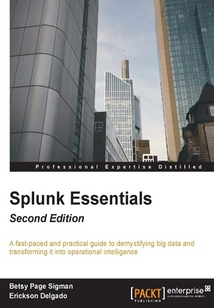舉報 

會員
Splunk Essentials(Second Edition)
最新章節:
Summary
ThisbookwillbeperfectforyouifyouareaSoftwareengineerordeveloperorSystemadministratorsorBusinessanalystwhoseektocorrelatemachinedatawithbusinessmetricsandprovideintuitivereal-timeandstatisticalvisualizations.SomeknowledgeorexperienceofpreviousversionsofSplunkwillbehelpfulbutnotessential.
目錄(88章)
倒序
- 封面
- 版權頁
- Credits
- About the Authors
- About the Reviewer
- www.PacktPub.com
- Why subscribe?
- Preface
- What this book covers
- What you need for this book
- Who this book is for
- Conventions
- Reader feedback
- Customer support
- Chapter 1. Splunk in Action
- Your Splunk.com account
- Installing Splunk on Windows
- Creating a Splunk app
- Populating data with Eventgen
- Controlling Splunk
- Configuring Eventgen
- Viewing the Destinations app
- Creating your first dashboard
- Summary
- Chapter 2. Bringing in Data
- Splunk and big data
- Splunk data sources
- Creating indexes
- Buckets
- Data inputs
- Splunk events and fields
- Extracting new fields
- Summary
- Chapter 3. Search Processing Language
- Anatomy of a search
- Time modifiers
- Filtering search results
- Search command - stats
- Search command - top/rare
- Search commands - chart and timechart
- Search command - eval
- Search command - rex
- Summary
- Chapter 4. Data Models and Pivot
- Creating a data model
- Data model acceleration
- Rearranging your dashboard
- Summary
- Chapter 5. Data Optimization Reports Alerts and Accelerating Searches
- Data classification with event types
- Data normalization with tags
- Data enrichment with lookups
- Creating reports
- Creating alerts
- Search and report acceleration
- Scheduling best practices
- Summary indexing
- Summary
- Chapter 6. Panes of Glass
- Creating effective dashboards
- Types of dashboard
- Form inputs
- Creating a time range input
- Creating a radio input
- Creating a dropdown input
- Static Real-Time dashboard
- Creating a map called a choropleth
- Summary
- Chapter 7. Splunk SDK for JavaScript and D3.js
- Introduction to Splunk SDKs
- Practical applications of Splunk's SDK
- Creating the final dashboard\jobs.js
- Summary
- Chapter 8. HTTP Event Collector
- What is the HEC?
- How does the HEC work?
- How data flows to the HEC?
- Summary
- Chapter 9. Best Practices and Advanced Queries
- Temporary indexes and oneshot indexing
- Searching within an index
- Search within a limited time frame
- Quick searches via fast mode
- Using event sampling
- Splunk Universal Forwarders
- Advanced queries
- How to improve logs
- Summary 更新時間:2021-07-08 11:47:57
推薦閱讀
- 新編Visual Basic程序設計上機實驗教程
- Mastering ServiceStack
- Mastering Ember.js
- 樂學Web編程:網站制作不神秘
- Learning Elixir
- SEO實戰密碼
- Getting Started with Python Data Analysis
- 學習正則表達式
- C#實踐教程(第2版)
- 持續集成與持續交付實戰:用Jenkins、Travis CI和CircleCI構建和發布大規模高質量軟件
- 編程可以很簡單
- Responsive Web Design with jQuery
- ASP.NET Core 2 High Performance(Second Edition)
- Unity與C++網絡游戲開發實戰:基于VR、AI與分布式架構
- AngularJS by Example
- Go語言從入門到進階實戰(視頻教學版)
- Mastering Kali Linux for Advanced Penetration Testing(Second Edition)
- 深入解析WPF編程
- C#從入門到精通(第5版)
- 來吧,一起創客
- Helm學習指南:Kubernetes上的應用程序管理
- R語言與數據可視化
- Refactoring TypeScript
- Home Automation with Intel Galileo
- 好設計,有方法:我們在搜狐做產品體驗設計
- Visual C
- XML實用技術自學經典
- Building Websites with the ASP.NET Community Starter Kit
- HTML5 Graphing and Data Visualization Cookbook
- Python編程課

